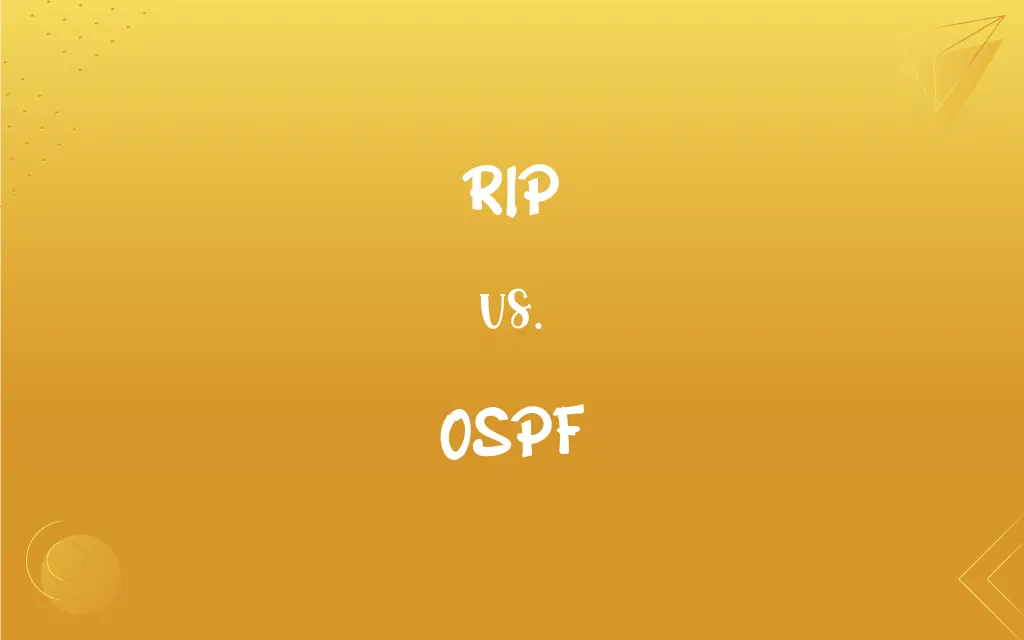RIP vs. OSPF: What's the Difference?
Edited by Aimie Carlson || By Harlon Moss || Published on February 9, 2024
RIP (Routing Information Protocol) uses hop count as its metric and has a simpler, distance-vector routing algorithm, while OSPF (Open Shortest Path First) is a more complex link-state protocol using cost as its metric.

Key Differences
RIP, or Routing Information Protocol, is a distance-vector routing protocol primarily used in smaller, less complex networks due to its simpler configuration. In contrast, OSPF (Open Shortest Path First) is a link-state protocol, more suitable for larger, complex networks as it provides greater scalability and efficiency in route calculation. Both RIP and OSPF are used for dynamic routing, automatically updating route information within a network.
RIP uses hop count as its primary metric to determine the best path, limiting the network size due to a maximum hop count of 15. OSPF, however, uses cost based on bandwidth as its metric, allowing for more flexibility and efficiency in larger networks. While RIP's simplicity is advantageous for smaller networks, OSPF's sophisticated metric system makes it preferable for larger, more diverse network environments.
In terms of convergence, RIP generally has slower convergence times due to its periodic updates and the distance-vector algorithm. OSPF offers faster convergence using immediate state changes in the network, thanks to its link-state nature. Both RIP and OSPF aim to maintain accurate and efficient routing tables, but OSPF provides a quicker response to network changes.
RIP is easier to configure and requires less computational power, making it a cost-effective solution for smaller networks. OSPF, with its complex algorithm and greater memory and processing requirements, is more resource-intensive but provides more robust and efficient network management. Both protocols serve different network requirements and are chosen based on network size, complexity, and resource availability.
RIP’s routing updates are broadcasted or multicasted periodically, which can lead to higher network traffic in larger networks. OSPF minimizes unnecessary traffic by sending updates only when network changes occur. While RIP is suitable for networks where frequent changes are less common, OSPF is more efficient in environments where network changes are more frequent and dynamic.
ADVERTISEMENT
Comparison Chart
Routing Algorithm
Distance-vector
Link-state
Metric
Hop count
Cost (based on bandwidth)
Network Size Suitability
Better for smaller networks
Suitable for larger, complex networks
Convergence Speed
Slower due to periodic updates
Faster due to immediate state changes
Configuration Complexity
Simpler, easier to configure
More complex, requires detailed configuration
ADVERTISEMENT
RIP and OSPF Definitions
RIP
RIP is suitable for small to medium-sized networks.
They implemented RIP for their campus network to efficiently manage connectivity.
OSPF
OSPF is designed for large-scale networks and ISPs.
The ISP deployed OSPF to handle their extensive network routing efficiently.
RIP
RIP updates its routing table every 30 seconds.
To maintain updated route information, RIP broadcasts routing information periodically.
OSPF
OSPF supports more complex network topologies.
Their large corporate network utilized OSPF to manage its complex topology.
RIP
RIP is a routing protocol using hop count as its metric.
The network used RIP to ensure data packets didn't travel through more than 15 hops.
OSPF
OSPF provides faster convergence than distance-vector protocols.
OSPF's quick convergence times are essential for the network's dynamic environment.
RIP
RIP limits the network to 15 hops to prevent routing loops.
The limitation of 15 hops in RIP helps in avoiding complex routing loops in the network.
OSPF
OSPF is a link-state routing protocol using cost as its metric.
OSPF was chosen for its ability to calculate the most efficient path based on link cost.
RIP
RIP is a distance-vector protocol.
RIP uses a distance-vector mechanism, making it simpler for small network infrastructures.
OSPF
OSPF minimizes unnecessary network traffic.
To reduce the network load, OSPF only sends updates when network changes occur.
FAQs
How does OSPF determine the best route?
OSPF uses cost, often based on bandwidth, as the metric for route selection.
How does RIP determine the best route?
RIP uses hop count as the metric to determine the shortest path.
Does OSPF have a hop count limit?
OSPF does not use hop count as a metric, so it doesn't have a hop count limit.
Is RIP suitable for large networks?
RIP is less suitable for large networks due to its hop count limit and slower convergence.
Is OSPF suitable for small networks?
While OSPF can be used in small networks, it's often overkill due to its complexity.
How often does RIP update its routing table?
RIP updates its routing table every 30 seconds.
What is OSPF?
OSPF is a link-state routing protocol designed for larger and more complex networks.
What is RIP?
RIP is a distance-vector routing protocol used in smaller networks.
Does OSPF require more resources than RIP?
Yes, OSPF requires more computational power and memory.
What is the hop count limit in RIP?
RIP limits routes to a maximum of 15 hops.
Does RIP require a lot of computational resources?
RIP is less resource-intensive compared to OSPF.
How does OSPF handle routing updates?
OSPF sends updates only when there are changes in the network topology.
How is OSPF better than RIP in terms of scalability?
OSPF is more scalable due to its ability to handle larger and more complex networks.
Can RIP handle complex network topologies?
RIP is less effective in complex topologies due to its simplicity.
Are there different versions of RIP?
Yes, there are two main versions: RIP version 1 and RIP version 2.
Is OSPF efficient in handling network changes?
Yes, OSPF quickly adapts to network changes, providing efficient routing.
Can RIP and OSPF work together in a network?
Yes, they can be used together with proper configuration and route redistribution.
Is RIP easier to configure than OSPF?
Yes, RIP's simplicity makes it easier to configure.
What are areas in OSPF?
Areas in OSPF are a way to subdivide and manage large networks efficiently.
How does OSPF improve upon the limitations of RIP?
OSPF offers better scalability, faster convergence, and more efficient routing.
About Author
Written by
Harlon MossHarlon is a seasoned quality moderator and accomplished content writer for Difference Wiki. An alumnus of the prestigious University of California, he earned his degree in Computer Science. Leveraging his academic background, Harlon brings a meticulous and informed perspective to his work, ensuring content accuracy and excellence.
Edited by
Aimie CarlsonAimie Carlson, holding a master's degree in English literature, is a fervent English language enthusiast. She lends her writing talents to Difference Wiki, a prominent website that specializes in comparisons, offering readers insightful analyses that both captivate and inform.































































